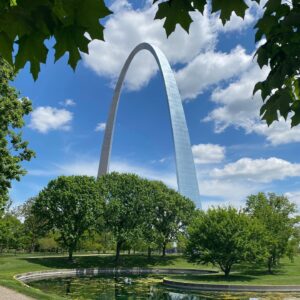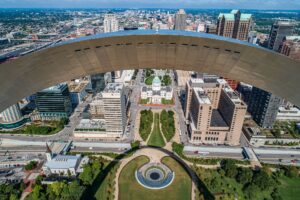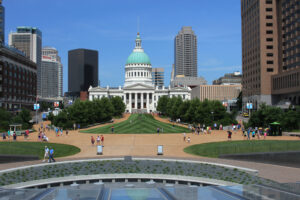
Gateway Arch Invites Code Council Conference Attendees to Visit the Nation’s Tallest Monument
At 630 feet high, Gateway Arch is a sight to behold and an experience unlike any other, providing Code Council Conference attendees with a unique excursion.
It won’t be long before thousands of building safety professionals travel to St. Louis, Mo. for the International Code Council’s 2023 Annual Conference and Expo (October 8-11). There’s still time to register, take full advantage of the exciting agenda and plan for everything the city has to offer.
St. Louis Union Station and the Zoo Museum District are just two of the many must-see attractions and experiences that have made St. Louis one of the world’s greatest places to visit. Gateway Arch is another, providing conference attendees with the perfect opportunity to explore the nation’s tallest monument — it will be a stop on this year’s St. Louis Architectural Tour on Sunday, Oct. 8.
SEE RELATED: Must-Attend Events at the Code Council’s 2023 Annual Conference

St. Louis’s Gateway Arch
Steeped in history and located in the heart of St. Louis, Gateway Arch is just a 20-minute walk from America’s Center, the home of this year’s conference and expo. Featuring 142 total sections, more than 5,000 tons of steel and 38,107 tons of concrete, Gateway Arch is 630 feet high. It was constructed over a two-year period starting with the placement of the first steel section on Feb. 12, 1963. Construction concluded on Oct. 28, 1965, when the arch’s last section was installed at the very top.
The cost totaled $13.4 million (more than $129 million when adjusted for inflation), but the fee did not include the $2 million tram system, which would not be completed for another two years. At that time, people simply admired Gateway Arch from the ground level, both for the architectural breakthrough that was achieved by creating the arch and for its significance to the city of St. Louis.
“During the Great Depression in the 1930s, civic leaders here in St. Louis wanted to boost jobs and civic pride,” said Pam Sanfilippo, Program Manager for Museum Services and Interpretation at Gateway Arch National Park. “One of them, Luther Ely Smith, came up with the idea that the St. Louis Riverfront area should commemorate the rich history of St. Louis and its role in the Westward expansion of the United States.”
In 1935, President Franklin D. Roosevelt signed an executive order establishing Jefferson National Expansion Memorial. Named after President Thomas Jefferson, the memorial was the catalyst for the construction of a national monument. No one knew what that monument should be or look like until a competition was held in 1940.

Eero Saarinen, a Finnish-American architect, won the competition with his concept for what would later become the Gateway Arch.
Despite the concern that construction would be difficult and dangerous, Gateway Arch was completed without any fatal injuries.
“It’s a testament to the safety and carefulness of all of the builders, which is very significant,” said Sanfilippo. “It’s the builders who made Saarinen’s vision a reality, and we honor them every year at the end of October. We hold an event inviting all those who helped build the arch to come and share their stories of their part in it.”
Gateway Arch National Park
From its inception, Gateway Arch has taken center stage at Jefferson National Expansion Memorial. Locals often referred to it as “the arch” (and still do), but few realized that it was part of the National Park Service. These two factors inspired a name change in 2018, when the memorial became Gateway Arch National Park.
The park includes more than the Gateway Arch; it also features the Old Courthouse, where Dred and Harriet Scott first sued for their freedom in 1846. The Old Courthouse is temporarily closed for renovations, but its significance – not only to St. Louis but to the entire United States – should not be understated.
Gateway Arch National Park also offers riverboat cruises, a virtual reality experience, a Halloween-themed party for all ages, and a museum with six themed exhibits that highlight America’s pioneering spirit.
To this day, President Dwight D. Eisenhower is the only president who has made it to the top. During his visit in 1967, he ignored Secret Service and went straight for the newly opened tram, which can be best described as a mix of an elevator and a Ferris wheel. The ride has proven to be a fun excursion for everyday visitors.

However, with each tram limited to five occupants and no way to easily exit, Secret Service has urged each president to avoid the trip. That didn’t stop President Eisenhower, who ascended the arch after hours (after tourists had left).. Prince Charles reached the top as well in 1977, more than four decades before becoming king.
“We’re seeing a big rebound this year,” said Sanfilippo. “Currently we’re at just over one million visitors for the year through August. Last year we hit 1.6 million for the entire year, so we fully expect we will surpass that number.”
Learn more about the St. Louis Architectural Tour at the Code Council’s 2023 Annual Conference and Expo, and the other building tours and educational opportunities, here.








